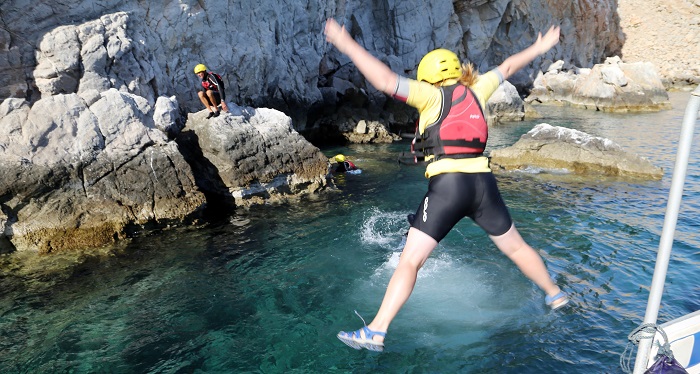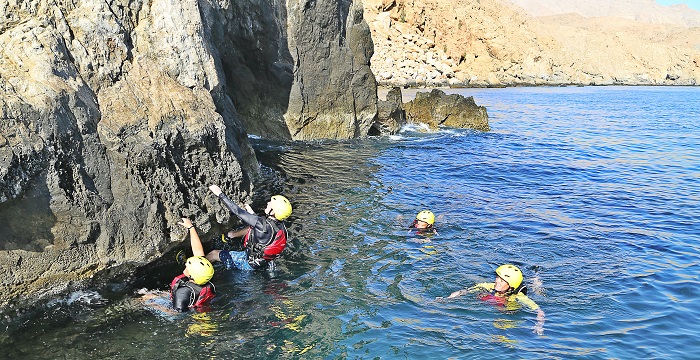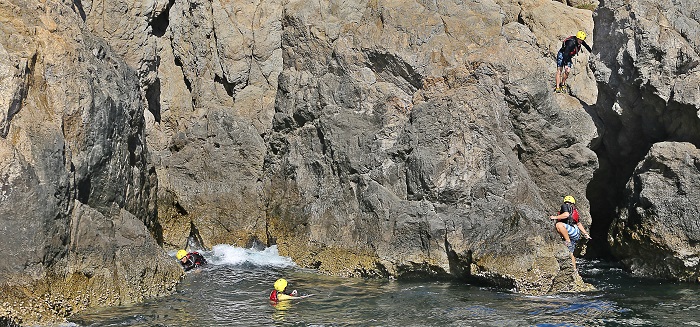Words By: Sean James
Models: Nathan Hill, Tim Stuart, Jess Brown and Jo McDonough
Many go to Musandam and stay dry; others go with the deliberate intention of getting wet. We have all seen the National Geographic video of the superstar climbers high above the fjords of Musandam, Northern Oman. It looks dangerous, risky, impossible but also thrilling. It is probably too much for the average person on a weekend trip from Dubai. However there is an activity that is very accessible to the adventurer looking for fun and excitement on the Musandam Peninsula.
The connection between the mountains and the sea is what makes Musandam so special. The cliffs drop directly down from as high as 2000m, plunging into the ocean. Many parts are only accessible by boat. Hikers, even if they do find the old paths of the locals still cannot experience the wildlife, fun and adventure there is to be had where the waves smash into the boulders at sea level. The British have done a lot for the Arabian Peninsula in the past and now they have introduced something different: Coasteering.
Coasteering is about to one of the fastest growing activities in Musandam. It is a mixture of climbing, scrambling, swimming, weaseling and deep water soloing (DWS). However, the advantage that coasteering has over all the others is that a complete novice can have a good time as just as someone who has been at it many times would. The aim is not to do the hardest climb or longest swim. It simply is to experience the thrill of floating in the ocean, occasionally climbing out, over, around or through the rocks to explore the next part of the journey.

I spent some years working off the rocky coast of North Wales and this was easily the most popular and enjoyable activity amongst groups. In North Wales the water was cold and the waves were big but we still managed to get groups to throw themselves repeatedly into the wild ocean either from a great height or a simple step out into the surging, frothing waters. Here in the Middle East, coasteering is perfectly suited to our climate. Even in the winter the water temperatures don’t require a wetsuit. Sometimes there is a swell through the Gulf which gives added excitement as you are washed to and fro by the tide. In the summer, coasteering is even more perfect as you spend a lot of time in the water to stay away from the humidity.
The term coasteering was originally invented in the 1980s by surfers as they scrambled around the base of cliffs looking for the best breaks and waves. Now, coasteering is an outdoor activity in its own right. I spent a week in Dibba and Musandam recently, exploring the best places to practice this activity.
What is coasteering?

It is many things. With an experienced and knowledgeable guide, it is extreme rock pooling and cliff jumping, an aquatic nature-trail, it can be swimming, bodysurfing waves, exploring coastal caves or finding hidden passages. In general it’s about discovering life at the bottom of the sea cliffs. If you can’t climb it, you simply jump off and swim around to an easier section.
Of course any activity that takes place in the sea, with tides and rocks will have a dangerous element to it. A guide will teach you the correct techniques, fit you with appropriate equipment and impart knowledge on the tides and local conditions. They may also be able to point out some of the local wildlife. On my numerous trips to Musandam, I have been lucky enough to see falcons, herons and a wide variety of sea creatures including dolphins.
There is also a training element to coasteering. You will be invigorated and build strength and coordination without even thinking about it. You spend all day hopping in and out of the water, only stopping in for lunch on the boat comprised of hummus and flatbread. If you’re lucky, the boat driver might show you his favourite beach which his family probably owns and invite you over for tea or coffee.
Changing tides, waves and wildlife make every coasteering trip unique. One minute you might be swimming lazily past the scenery, the next you could be rinsed in Neptune’s own washing machine. You might see peregrine falcons and swim with a seal. Over an average two-hour session you’ll probably scramble over rocks, swim into canyons, explore caves, bodysurf the breakers, peer into rock pools, learn about geology and leap off a cliff.
What equipment do you need?
If you sign up with a commercial company, they will provide you with a buoyancy aid and a helmet. A wetsuit is useful but can be too hot in the summer. Expect a few scrapes and bruises as you drift along and occasionally bump into submerged rocks. Old running shoes and even gloves are ideal for when you climb over barnacled rocks and jump from the top of small cliffs.
It really is that simple. Grab yourself a wetsuit, buoyancy aid and helmet and you’re ready. You don’t even have to be able to swim although it helps. People are usually amazed at what they can achieve and how little skill they require. The hardest step is often the first so make an effort and you won’t be disappointed.
Where can you coasteer?

Coasteering can be done anywhere there is a combination of cliffs and coastline. A good day of coasteering will take place in areas with bays, ledges, caves and features. The east coast of Musandam using Dibba as a starting point is ideal. The further up the coast you go the more remote and isolated it is. Alternatively you can use Khasab further to the west as a base. Take a speed boat for the day and stop wherever you spot. With almost 1000kms of coastline in Musandam you won’t be short of something to do.
Guidelines
The Musandam area like all wilderness areas is special, so make sure that you follow some simple guidelines to help preserve it:
- Respect people particularly the local community and other users.
- Ensure that you have up to date information on venues that you are visiting. Don’t visit areas that are sensitive, restricted access or wildlife breeding colonies.
- Go in a group that is appropriate to the venue and be aware not to overcrowd sites.
- If changing into or out of your coasteering kit at the venue, be sure to brief your group to maintain modesty at all times, and to use appropriate toilet facilities
- Show respect for other users of the coast by keeping noise to a minimum when coasteering along a tranquil stretch of the coast. The tranquillity of the wilderness is special.
- Observe, but avoid disturbing wildlife – be prepared to change your route if necessary. Protect the natural environment.
- Leave the coast tidier than it was when you arrived – where possible, pick up litter as you go, especially old fishing tackles and plastics which can be a real hazard for wildlife
- Do not damage the rocks, or remove any fossils from the coast.
- Enjoy the outdoors and stay safe.
Contact us at www.outdoorarabia.com for more information on our coasteering and other adventure packages and get more out of the region you live in.

